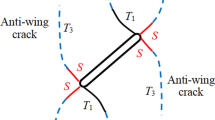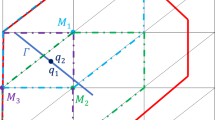Abstract
In this study, the formation of localized deformation band and failure processes of brittle–ductile materials (coarse and medium marbles) containing pre-existing flaws under various loading conditions are simulated numerically. By incorporating the modified Mohr–Coulomb crack initiation criterion and the crack evolution techniques, the cracking processes, such as crack initiation, propagation and coalescence are successfully modeled by the developed numerical manifold method. According to the results, the development of macro-shear cracks is preceded by the development of localized deformation bands, which are underlain by damage accumulation and material deterioration. The numerical results are comparable to the laboratory test results.























Similar content being viewed by others
References
An XM (2010) Extended numerical manifold methods for engineering failure analysis. Ph.D.Thesis, Nanyang Technology University, Singapore
Belytschko T, Black T (1999) Elastic crack growth in finite elements with minimal remeshing. Int J Numer Methods Eng 45(5):601–620
Belytschko T, Lu YY, Gu L (1994) Element-free galerkin methods. Int J Numer Methods Eng 37(2):229–256
Bobet A (1997) Fracture coalescence in rock materials: experimental observations and numerical predictions. Massachusetts Institute of Technology, Cambridge
Bobet A, Einstein HH (1998) Fracture coalescence in rock-type materials under uniaxial and biaxial compression. Int J Rock Mech Min Sci 35(7):863–888
Bombolakis EG (1963) Photoelastic stress analysis of crack propagation within a compressive stress field. Ph.D.Thesis. Massachusetts Institute of Technology, Cambridge
Bouchard PO, Bay F, Chastel Y (2003) Numerical modelling of crack propagation: automatic remeshing and comparison of different criteria. Comput Methods Appl Mech Eng 192 (35–36):3887–3908
Brady B, Brown E (1993) Rock mechanics for underground mining, 2nd edn. Chapman & Hall, London, pp 106–108
Chen WF, Han DJ (1988) Plasticity for structural engineers. Springer, New York
Chiou YJ, Lee YM, Tsay RJ (2002) Mixed mode fracture propagation by manifold method. Int J Fract 114(4):327–347
Cotterell B, Rice JR (1980) Slightly curved or kinked cracks. Int J Fract 16:155–169
Cundall PA, Strack ODL (1979) Discrete numerical-model for granular assemblies. Geotechnique 29(1):47–65
Donze FV, Bouchez J, Magnier SA (1997) Modeling fracturing in rock blasting. Int J Rock Mech Min Sci 34(8): 1153–1163
Donze FV, Richefeu V, Magnier SA (2009) Advances in discrete element method applied to soil, rock and concrete mechanics. Electron J Geotech Eng 8:1–44
Drucker D, Prager W (1952) Soil mechanics and plastic analysis of limit design. Quat Appl Math 10(2)
Erdogan F, Sih SC (1963) On the crack extension in paltes under plane loading and transverse shear. J Basic Eng ASME 85:519–525
Huang JF, Chen GG, Zhao YH, Wang R (1990) An experimental-study of the strain field development prior to failure of a marble plate under compression. Tectonophysics 175(1–3): 269–284
Hussian MA, PU, Underwood J (1974) Strain energy release rate for a crack under combined mode I and mode II. Fract Anal ASTM STP 560:2–28
Ingraffea AR, Heuze FE (1980) Finite-element models for rock fracture-mechanics. Int J Numer Anal Methods Geomech 4(1):25–43
Khan SMA, Khraisheh MK (2000) Analysis of mixed mode crack initiation angles under various loading conditions. Eng Fract Mech 67(5):397–419
Li SC, Cheng YM (2005) Enriched meshless manifold method for two-dimensional crack modeling. Theor Appl Fract Mech 44(3):234–248
Li S, Cheng Y, Wu YF (2005a) Numerical manifold method based on the method of weighted residues. Comput Mech 35(6):470–480
Li YP, Chen LZ, Wang YH (2005b) Experimental research on pre-cracked marble under compression. Int J Solids Struct 42(9–10):2505–2516
Ma GW, An XM, Zhang HH, Li LX (2009) Modeling complex crack problems using the numerical manifold method. Int J Fract 156(1):21–35
Martinez A (1999) Fracture coalescence in natural rock. M.Sc, Thesis, Massachusetts Institute of Technology, Cambridge
Meldelson A (1986) Plastic stress-strain relations. In: Plasticity: theory and application, 2edn. Krieger Publishing, Malabar
Melenk JM, Babuska I (1996) The partition of unity finite element method: basic theory and applications. Comput Methods Appl Mech Eng 139(1–4):289–314
Ning YJ, An XM, Ma GW (2011) Footwall slope stability analysis with the numerical manifold method. Int J Rock Mech Min Sci 48(6):964–975
Park CH, Bobet A (2010) Crack initiation, propagation and coalescence from frictional flaws in uniaxial compression. Eng Fract Mech 77(14):2727–2748
Petit J, Barquins M (1988) Can natural faults propagate under mode II conditions? Tectonics 7(6):1246–1265
Potyondy DO, Cundall PA (2004) A bonded-particle model for rock. Int J Rock Mech Min Sci 41(8):1329–1364
Rabczuk T, Belytschko T (2004) Cracking particles: a simplified meshfree method for arbitrary evolving cracks. Int J Numer Methods Eng 61(13):2316–2343
Rabczuk T, Areias PMA, Belytschko T (2007) A simplified mesh-free method for shear bands with cohesive surfaces. Int J Numer Methods Eng 69(5):993–1021
Reyes O, Einstein HH (1991) Failure mechanisms of fractured rock- a fracture coalescence model. In: Proceedings—seventh international congress on rock mechanics, vol 1. Rock Mechanics and, Environmental Protection. pp 333–341
Shen BT, Stephansson O, Einstein HH, Ghahreman B (1995) Coalescence of fractures under shear stresses in experiments. J Geophys Res Solid Earth 100(B4):5975–5990
Shi GH (1991) Manifold method of material analysis. In: Paper presented at the Trans 9th Army conference on applied mathematics and computing. Minesota, Minneaplolis
Shi GH (1992) Modeling rock joints and blocks by manifold method. In: Proceedings of the 33th US rock mechanics symposium. San Ta Fe, New Mexico, pp 639–648
Shi GH, Goodman RE (1989) Generalization of two-dimensonal discontinuous deformation analysis for forward modeling. Int J Numer Anal Methods Geomech 13:359–380
Sih GC (1974) Strain-energy-density factor applied to mixed crack problems. Int J Fract 10:305–321
Stefanov YP (2004) Numerical investigation of deformation localization and crack formation in elastic brittle-plastic materials. Int J Fract 128:345–352
Strouboulis T, Babuska I, Copps KL (2000a) The design and analysis of the generalized finite element method. Comput Methods Appl Mech Eng 181(1–3):43–69
Strouboulis T, Copps K, Babuska I (2000b) The generalized finite element method: an example of its impementaion and illustration of its performance. Int J Numer Anal Methods Geomech 47(8):1401–1417
Trädegård A, Nicholas F, Ostlund S (1998) FEM-remeshing technique applied to crack growth problems. Comput Methods Appl Mech Eng 160:115–131
Tsay RJ, Chiou YJ, Chuang WL (1999) Crack growth prediction by manifold method. J Eng Mech ASCE 125(8):884–890
Vermeer PA, de Borst R (1984) Non-associated plasticity for soils, concrete and rock. Heron 29(3):1–64
Wong RHC, Chau KT (1998) Crack coalescence in a rock-like material containing two cracks. Int J Rock Mech Min Sci 35(2):147–164
Wong LNY, Einstein HH (2007) Coalescence behavior in Carrara marble and molded gypsum containing artificial flaw pairs under uniaxial compression. In: 1st Canada-U.S. rock mechanics symposium, Vancouver, May 27–31, 2007
Wong LNY, Einstein HH (2009a) Crack coalescence in molded gypsum and Carrara marble: part 2-microscopic observations and interpretation. Rock Mech Rock Eng 42(3):513–545
Wong LNY, Einstein HH (2009b) Systematic evaluation of cracking behavior in specimens containing single flaws under uniaxial compression. Int J Rock Mech Min Sci 46(2):239–249
Wong LNY, Einstein HH (2010) Process zone development associated with cracking processes in Carrara marble. In: The 9th international conference on analysis of discontinuous deformation “New Developments and Applications”. Nanyang Technological University, Singapore, 25–27 November 2009, pp 581-588
Wong LNY, Zou C (2012) Cracking processes in rocks under dynamic loading. In: 7th Asian rock mechanics symposium, an ISRM regional symposium, Seoul, Korea, October 15–19, 2012, pp 485–494
Wong RHC, Chau KT, Tang CA, Lin P (2001) Analysis of crack coalescence in rock-like materials containing three flaws—part I: experimental approach. Int J Rock Mech Min Sci 38(7):909–924
Wu ZJ, Wong LNY (2012) Fricitonal crack initiation and propagtion analysis using the numerical manifold method. Comput Geotech 39:38–53
Yang SQ, Jing HW (2011) Strength failure and crack coalescence behavior of brittle sandstone samples containing a single fissure under uniaxial compression. Int J Fract 168(2):227–250
Yang SQ, Jiang YZ, Xu WY, Chen XQ (2008) Experimental investigation on strength and failure behavior of pre-cracked marble under conventional triaxial compression. Int J Solids Struct 45(17):4796–4819
Zhang XP, Wong LNY (2012) Cracking processes in rock-like material containg a single flaw under uniaxial compression: a numerical study based on parallel bonded-model approach. Rock Mech Rock Eng 45:711–737
Zhang XP, Wong LNY Crack initiation, propagation and coalescence in rock-like material containing two flaws: a numerical study based on bonded-particle model approach. Rock Mech Rock Eng (in press)
Zou C, Wong LNY, Cheng Y (2012) The strength and crack behaviour of rock-like gypsum under high strain rate. In: 46th US rock mechanics/ geomechanics symposium, Chicago, IL, June 24–27, 2012. ARMA, pp 312–339
Acknowledgments
The authors would like to thank Dr Youjun Ning for valuable discussion during the course of this research.
Author information
Authors and Affiliations
Corresponding author
Rights and permissions
About this article
Cite this article
Wu, Z., Wong, L.N.Y. Elastic–plastic cracking analysis for brittle–ductile rocks using manifold method. Int J Fract 180, 71–91 (2013). https://doi.org/10.1007/s10704-012-9802-3
Received:
Accepted:
Published:
Issue Date:
DOI: https://doi.org/10.1007/s10704-012-9802-3




